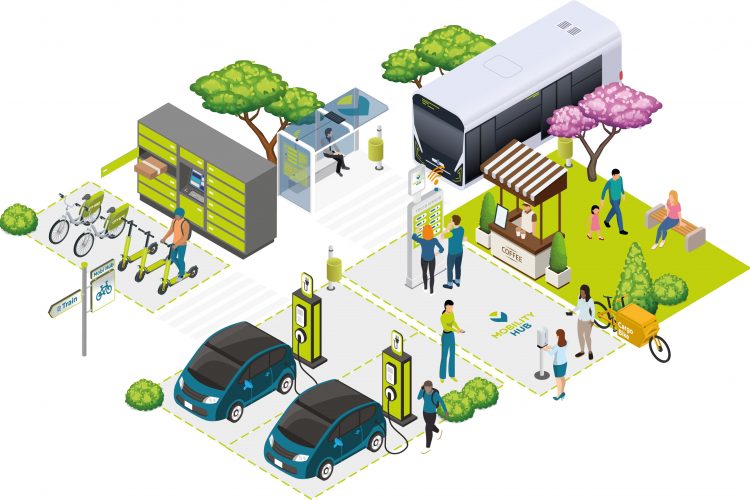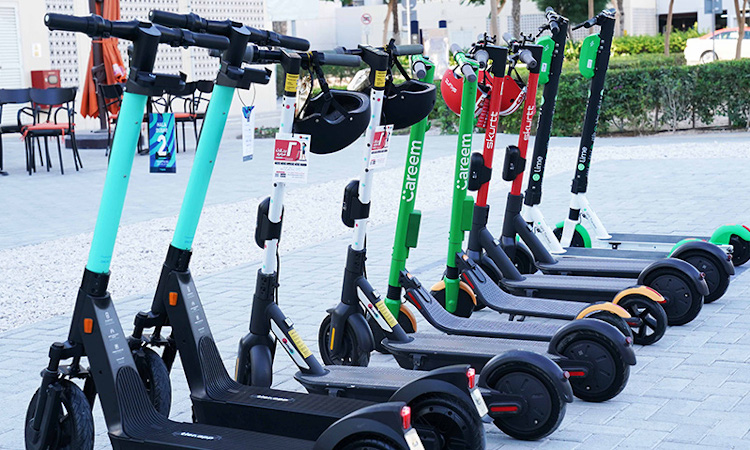Why mobility hubs are crucial to making transport more sustainable
- Like
- Digg
- Del
- Tumblr
- VKontakte
- Buffer
- Love This
- Odnoklassniki
- Meneame
- Blogger
- Amazon
- Yahoo Mail
- Gmail
- AOL
- Newsvine
- HackerNews
- Evernote
- MySpace
- Mail.ru
- Viadeo
- Line
- Comments
- Yummly
- SMS
- Viber
- Telegram
- Subscribe
- Skype
- Facebook Messenger
- Kakao
- LiveJournal
- Yammer
- Edgar
- Fintel
- Mix
- Instapaper
- Copy Link
Posted: 26 March 2021 | Richard Dilks - CoMoUK | 1 comment
Chief Executive of CoMo UK Richard Dilks explains why mobility hubs should play a key role in the green transport revolution, and explains how crucial they are in getting people out of private cars.


Mobility hubs are crucial to making transport more sustainable according to Richard Dilks Credit: CoMo UK
The quest for the silver bullet – the instant solution to a long-term problem – is an endless one. That is because it does not exist. The search for a transport intervention that can solve more than a single problem is less hopeless, but is certainly not a short one.
So when we find something that improves on several critical aspects of the issues we face as a transport sector with a big need to cut emissions, I think we should embrace it.
At CoMoUK, the national charity for the public benefit of shared transport such as car and bike share schemes, we have been first admiring the mobility hubs of continental Europe and the US, then adapting them conceptually for the UK, bringing together people who want to have them and defining accreditation standards for them.
What are mobility hubs?
The very phrase ‘mobility hub’ is not perfect (no label is). These are places which bring together public, shared and active travel modes with some public realm improvement and an identifying sign. This can range from a bus stop with parking for shared bikes by a cycle route, up to megahubs in large-scale new developments, at major transport interchanges, motorway service stations, hospitals and so on.
They deliver significant improvements for the environment, boost mental and physical health, and create places which everyone living nearby can be proud of.
They present economic opportunities too, with many of these hubs attracting new shops and commercial ventures as more people flock to use them.
They help supply and demand find each other across a range of sustainable transport options, boosting utilisation and cutting costs. At the same time, they can be used to suppress or eliminate private car parking, which is intimately connected to private car use – which in turn is part of what we must cut if we are to have a hope of meeting our legal commitment to net zero greenhouse gas emissions by 2050 at the latest.
They are natural homes for electric vehicle (car, e-bike, e-scooter, e-cargo bike) charging, for parcel pick up and drop off and broader logistics uses.


Mobility hubs lend themselves to micromobility modes such as e-scooters
The first CoMoUK accredited hub is on its way and a healthy pipeline of hubs is being planned up and down the country. The quarterly meeting we run that is open to all has gone from 20 attendees at inception last June to nearly 100 now. The first moves are being made to establish the hubs concept in planning laws.
They can also be very important amenities in their own right, and with the surge in home working brought about by the pandemic’s lockdowns, this may in fact be the majority use of some hubs – be it cafés, healthcare facilities or community spaces, including greenspace improvements such as new trees and plants. Sporting facilities, exercise points and other public services could also be introduced.
The concept and reality are flexible, so we believe there are use cases across urban, suburban, per-urban and rural locations. Employment sites are a natural part of the mix too.
Getting people out of private cars
We know that transport is the biggest polluter in the UK, contributing around a third of all emissions. Within that, private vehicles are the worst offenders.
So to make a considerable and sustained impact on this, we need to get people out of their own cars and engaged in different commuting habits.
These hubs encourage exactly that and, what’s more, they make the idea appealing.
We know from the behavioural change experts that we maximise our chances of achieving change if we make it easy, attractive, social and timely. Hubs have the power to do that.
We can’t simply shame people into changing their behaviour. It didn’t work with cigarettes and it won’t work here. We have to show that there’s something in it for them too alongside curbing the behaviours we need to see less of.
The hub also needs its digital twin – the tool which can help people plan and achieve their sustainable journeys in easy, attractive, timely ways. Hubs and a mobility as service offer go naturally together. These in turn can be combined with credit schemes or other incentives, potentially for those trading in and not replacing a privately owned car. That would build on the cost savings that using shared, public and active travel options can bring over owning a car.
Changing old habits
Hubs form helpful nodes on networks that are already being planned and built to boost cycling and walking. Our own studies from across the UK have found that people who use bike share schemes report notable increases in their mental wellbeing.
Think how high a proportion of time a private car sits idly outside someone’s home – it’s 95 per cent on average. Is there any other household commodity which spends so much time doing so little yet costs so much?
People who have made the switch away from car ownership – but still include car use as needed in their lives thanks to car sharing schemes – rarely go back. They appreciate the cash saved in fuel, insurance and expensive repair and maintenance bills. They also enjoy the newfound habits which come with being liberated from vehicle ownership, such as different routes to work, alternative modes of transport and more walking or cycling, which our research consistently finds they do.
Another group open to trying new habits are people who have just moved home. That’s why including mobility hubs in new developments is particularly powerful and can be part of making sites more pleasant and denser.
As we think of the post-pandemic future, mobility hubs could be an enormous positive throughout the length and breadth of this country.
Biography
Richard Dilks is chief executive of CoMoUK. He was previously transport programme director at the business group London First, where he led policy and advocacy across all transport modes and across services and infrastructure.
He was also a board member at the statutory transport watchdog London TravelWatch for six years, which was focussed primarily on public transport.
Prior to that he worked as first a journalist and then a policy adviser at the consumer body Which? on a wide range of consumer markets including transport.
Related topics
Accessibility, Air Quality, Alternative Power, COVID-19, Infrastructure & Urban Planning, Journey Planning, Mobility Services, Multimodality, On-Demand Transport, Passenger Accessibility, Passenger Experience, Public Transport, Sustainable Urban Transport, Transport Governance & Policy
Related cities
UK
Related organisations
CoMoUK









This post has inspired our group, Citizens for Alternative Transportation in Trent Lakes (CATTL) to pursue funding for this initiative for our community. Thank you for this article, it is incredibly valuable! Many transit solutions are awkward to apply in rural settings, but a mobility hub will make a huge postive impact for nature (climate change), independance and well-being.